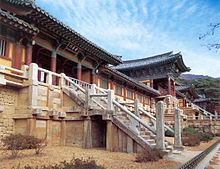Our website is made possible by displaying online advertisements to our visitors.
Please consider supporting us by disabling your ad blocker.
Bulguksa
| Bulguksa | |
|---|---|
 | |
| Location | |
| Location | Gyeongju, South Korea |
| Geographic coordinates | 35°47′24″N 129°19′56″E / 35.79000°N 129.33222°E |
| Official name: Bulguksa Temple | |
| Criteria | Cultural: i, iv |
| Designated | 1995 |
| Parent listing | Seokguram Grotto and Bulguksa Temple |
| Reference no. | 736 |
| Official name: Bulguksa Temple, Gyeongju | |
| Designated | 2009-12-21 |
| Reference no. | 502 |
| Website | |
| bulguksa | |
| Korean name | |
| Hangul | 불국사 |
| Hanja | 佛國寺 |
| Revised Romanization | Bulguksa |
| McCune–Reischauer | Pulguksa |
Bulguksa (Korean: 불국사) is a Buddhist temple on Tohamsan, in Jinhyeon-dong, Gyeongju, North Gyeongsang Province, South Korea.
It is a head temple of the Jogye Order of Korean Buddhism and contains six National Treasures, including the Dabotap and Seokgatap stone pagodas, Cheongun-gyo (Blue Cloud Bridge), and two gilt-bronze statues of Buddha. The temple is classified as Historic and Scenic Site No. 1 by the South Korean government.[1] In 1995, Bulguksa and the nearby Seokguram Grotto were added to the UNESCO World Heritage List.
The temple is considered as a masterpiece of the golden age of Buddhist art in the Silla kingdom. It is currently the head temple of the 11th district of the Jogye Order of Korean Buddhism.
Among the earliest woodblock prints in the world, a version of the Dharani sutra dated between 704 and 751 was found there in 1966.[2][3][4][5][6] Its Buddhist text was printed on a 8 cm × 630 cm (3.1 in × 248.0 in) mulberry paper scroll.
- ^ "Historic and Scenic Sites 1; Bulguksa Temple in Gyeongju". Cultural Heritage Administration. Archived from the original on 2007-09-30.
- ^ "North Korea — Silla". Countrystudies.us. Retrieved 2009-12-03.
- ^ "A History of Writings in Japanese and Current Studies in the Field of Rare Books in Japan - 62nd IFLA General Conference". Ifla.org. Archived from the original on 2008-11-20. Retrieved 2009-12-03.
- ^ "Gutenberg and the Koreans: The Invention of Movable Metal Type Printing in Korea". Rightreading.com. 2006-09-13. Retrieved 2009-12-03.
- ^ "by Cho Woo-suk, JoongAng Daily, November 22, 2004". Eng.buddhapia.com. Archived from the original on July 19, 2011. Retrieved 2009-12-03.
- ^ "National Treasure No. 126-6, by the Cultural Heritage Administration of South Korea (in Korean)". jikimi.cha.go.kr. Retrieved 2009-12-28.
Previous Page Next Page


